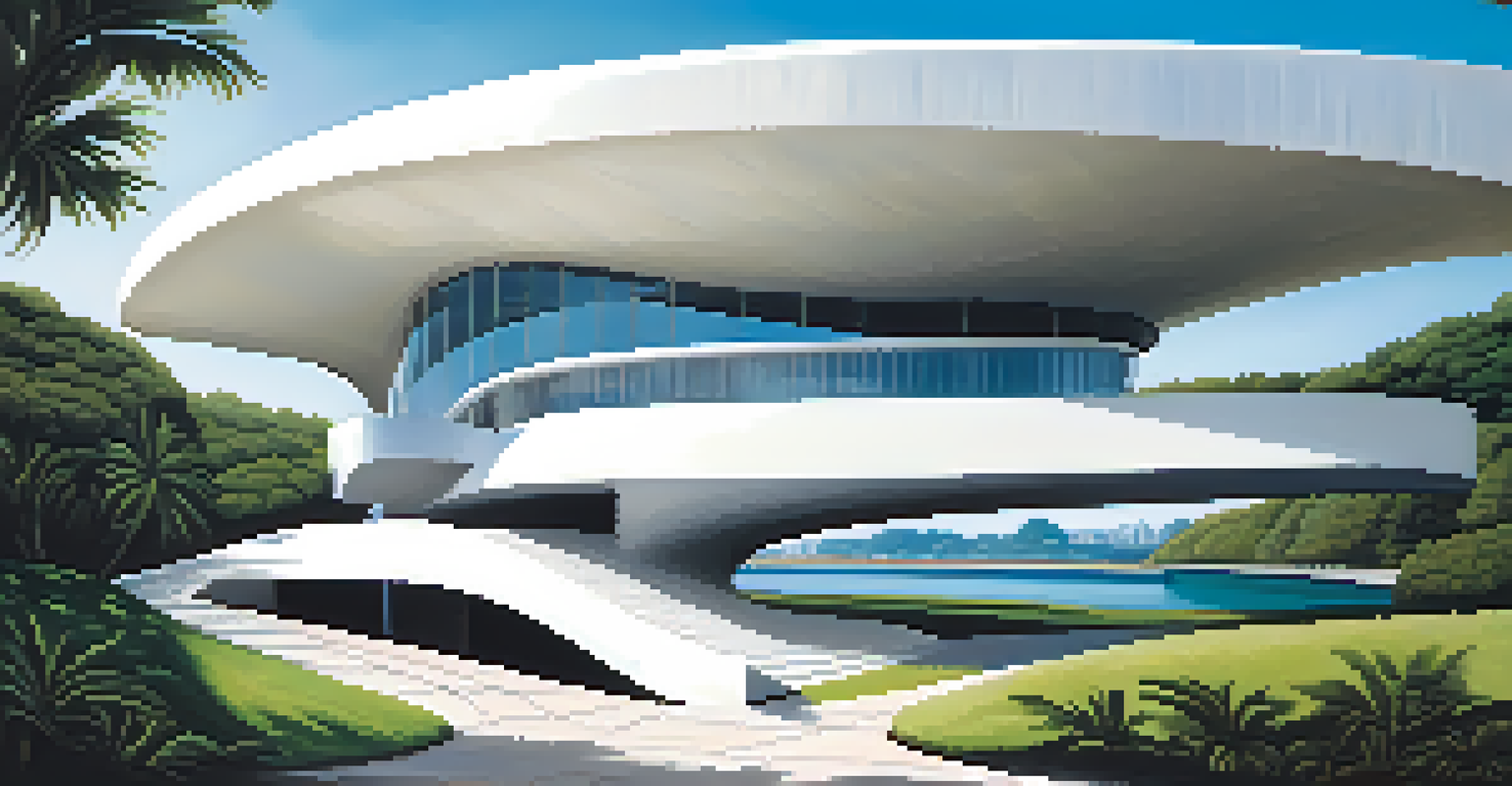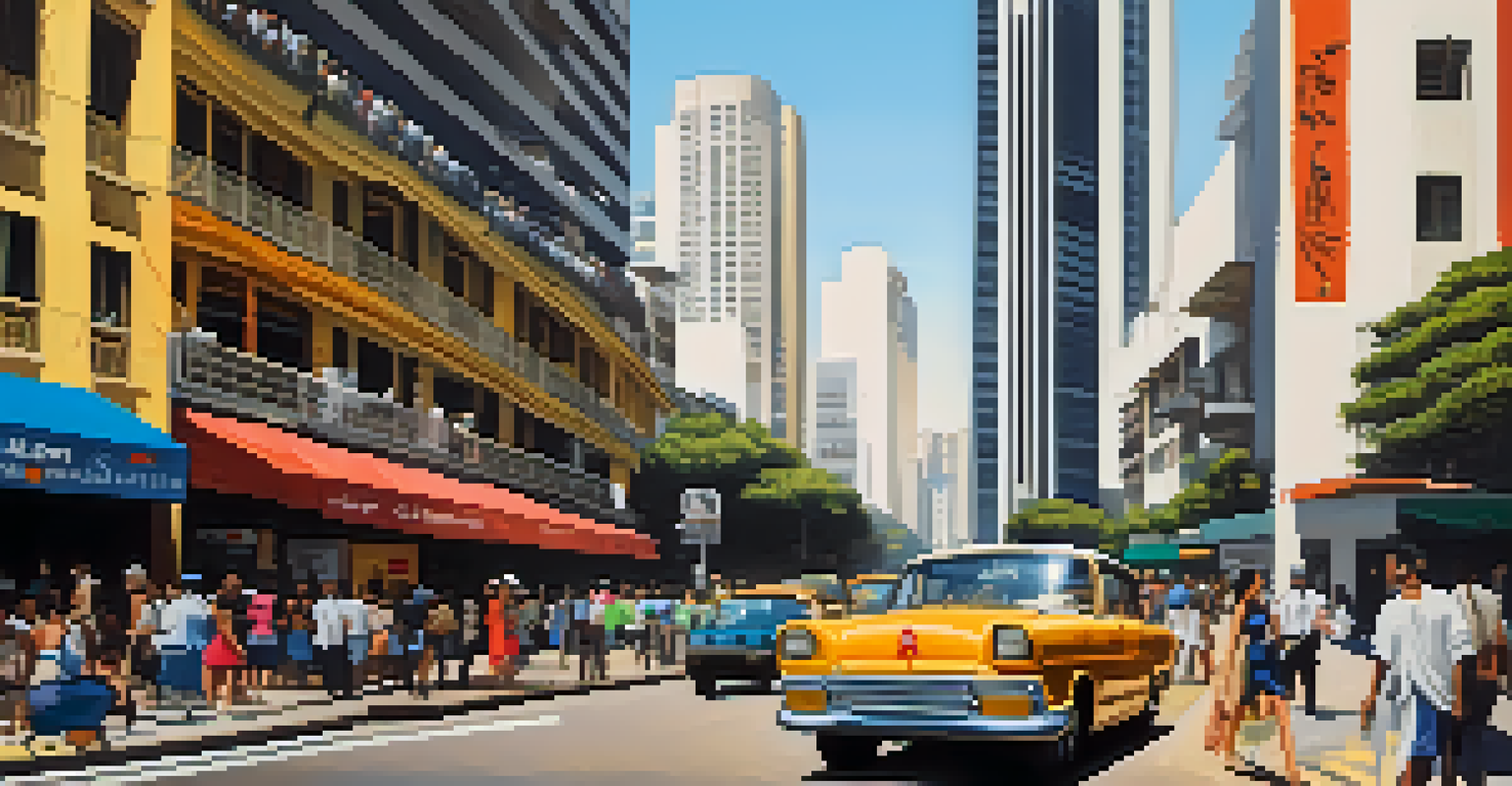Modernist Marvels: Brazil’s Iconic 20th Century Architecture

The Birth of Modernism in Brazil: A Cultural Revolution
In the early 20th century, Brazil underwent a cultural transformation that birthed modernism. Influenced by European movements, architects sought to break free from traditional styles and embrace new materials and designs. This shift reflected the country's unique identity, blending local culture with global ideas, paving the way for an architectural revolution.
Architecture is the art of how to waste space.
Prominent figures like Oscar Niemeyer and Lucio Costa emerged during this period, championing innovative designs that celebrated the beauty of curves and organic forms. Their visionary approach not only redefined urban landscapes but also symbolized Brazil's aspirations for progress and modernity. It was a time when architecture became a canvas for artistic expression.
As cities like Brasília began to take shape, the modernist movement started to gain international recognition. The integration of art and architecture became a hallmark of this era, with buildings that were not just functional but also visually stunning. This new architectural language would leave an indelible mark on Brazil’s identity and inspire future generations.
Brasília: A City Designed for the Future
Brasília, founded in 1960, is perhaps the most significant example of modernist architecture in Brazil. Designed by Oscar Niemeyer and Lucio Costa, the city was built with the vision of promoting national integration and modernity. Its unique layout, resembling an airplane from above, showcases how thoughtful urban planning can influence social interactions.

The buildings in Brasília, characterized by their bold forms and striking white facades, represent a radical departure from traditional architecture. Structures like the National Congress and the Cathedral of Brasília are not just government buildings; they are works of art that embody the ideals of the modernist movement. Each edifice tells a story of innovation, functionality, and beauty.
Modernism Transformed Brazilian Culture
The modernist movement in Brazil blended local culture with global influences, redefining architecture and national identity.
However, Brasília's modernist architecture has not been without controversy. Critics argue that the city lacks the warmth and vibrancy of older urban centers, raising questions about the relationship between architecture and community. Despite this, Brasília remains a UNESCO World Heritage site, celebrated for its visionary design and cultural significance.
Oscar Niemeyer: The Master of Curves
Oscar Niemeyer is synonymous with modernist architecture in Brazil, known for his daring use of curves and concrete. His philosophy centered around the belief that architecture should be a reflection of human feelings, aiming to evoke emotion through design. Niemeyer's work transcended mere functionality, becoming a celebration of form and light.
Good buildings come from good people, and all problems are solved by good design.
One of his most iconic projects is the Niterói Contemporary Art Museum, which appears to float above the landscape, challenging traditional architectural norms. The building's bold, futuristic design invites visitors to experience art in a space that feels alive and dynamic. This ability to harmonize art and architecture is what sets Niemeyer apart as a true innovator.
Throughout his career, Niemeyer designed numerous landmarks, each showcasing his signature style and commitment to modernism. His influence extends beyond Brazil, inspiring architects worldwide to embrace creativity and push boundaries. Niemeyer’s legacy remains etched in the skylines of cities, a testament to the power of visionary architecture.
The Impact of Modernism on Brazilian Identity
The rise of modernist architecture in Brazil coincided with a period of national awakening. As Brazil sought to define its identity on the global stage, architecture became a means of expressing cultural pride and innovation. Modernist buildings served not only as functional spaces but also as symbols of progress and a break from colonial pasts.
This architectural movement fostered a sense of unity and aspiration among Brazilians, as cities transformed with new, bold structures. The modernist ethos encouraged a collective vision of the future, promoting ideas of democracy and inclusivity. It was a time when architecture began to reflect the diverse and vibrant culture of Brazil.
Brasília: A Modernist Landmark
Designed by Oscar Niemeyer and Lucio Costa, Brasília exemplifies modernist principles with its innovative urban planning and striking buildings.
However, the journey was not without challenges. The complexities of urbanization and socio-economic disparities often clashed with modernist ideals. Nonetheless, the impact of modernist architecture on Brazilian identity remains profound, shaping how Brazilians see their cities and their place within the world.
São Paulo: A Modernist Metropolis
São Paulo, Brazil's largest city, showcases an eclectic mix of modernist architecture alongside historical buildings. The city became a canvas for modernist architects, who introduced innovative designs that transformed urban life. Landmarks like the Copan Building, designed by Oscar Niemeyer, epitomize the spirit of modernism with their flowing forms and functional elegance.
In São Paulo, modernism is not just about aesthetics; it's about addressing the needs of a growing urban population. Many modernist buildings were designed with social consciousness in mind, aiming to create spaces that foster community engagement. This approach reflects the belief that architecture can play a vital role in improving quality of life.
The city's skyline, dominated by modernist structures, tells a story of ambition and resilience. As São Paulo continues to evolve, the legacy of modernism lives on, inspiring new generations of architects to explore innovative solutions for urban challenges. The city stands as a vibrant testament to Brazil's architectural journey.
Preserving Brazil’s Modernist Heritage
As Brazil's modernist architecture faces the test of time, the importance of preservation has come to the forefront. Many iconic buildings are at risk due to neglect or the pressures of urban development. Efforts to protect these structures are crucial to maintaining the cultural heritage that they represent.
Organizations and advocates are working tirelessly to raise awareness about the significance of modernist architecture in Brazil. Initiatives like restoration projects and educational programs aim to engage communities in the preservation process. By fostering a sense of ownership and appreciation, these efforts help ensure that modernist landmarks remain part of Brazil's narrative.
Preserving Architectural Heritage
Efforts to preserve Brazil's modernist architecture are vital for maintaining cultural heritage amidst urban development pressures.
Additionally, the rise of tourism has prompted interest in Brazil's architectural heritage, offering opportunities to showcase its modernist gems. Guided tours and exhibitions highlight the beauty and significance of these structures, encouraging both locals and visitors to value the artistic and historical context of modernism in Brazil.
The Future of Modernist Architecture in Brazil
Looking ahead, the future of modernist architecture in Brazil is a blend of preservation and innovation. As new generations of architects emerge, there’s a growing dialogue about how to respect the past while embracing contemporary design. This balance will be crucial in shaping the urban landscape of Brazil in the years to come.
Sustainability is becoming a key focus in architectural practices, prompting a reevaluation of modernist principles. Integrating green technologies and eco-friendly materials into designs reflects a commitment to addressing environmental challenges. This evolution signifies a new chapter for modernism in Brazil, one that honors its roots while adapting to current needs.

Ultimately, the legacy of modernist architecture will continue to inspire, serving as a foundation for future developments. As Brazil navigates its architectural journey, the principles of creativity, innovation, and cultural pride will remain central in shaping vibrant urban environments that resonate with the spirit of the nation.